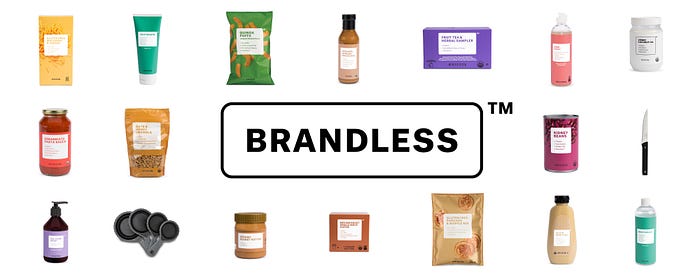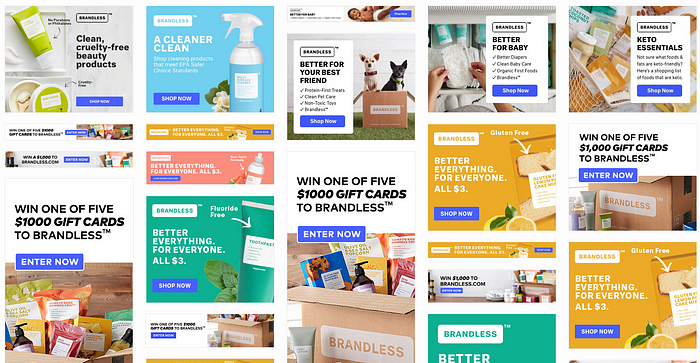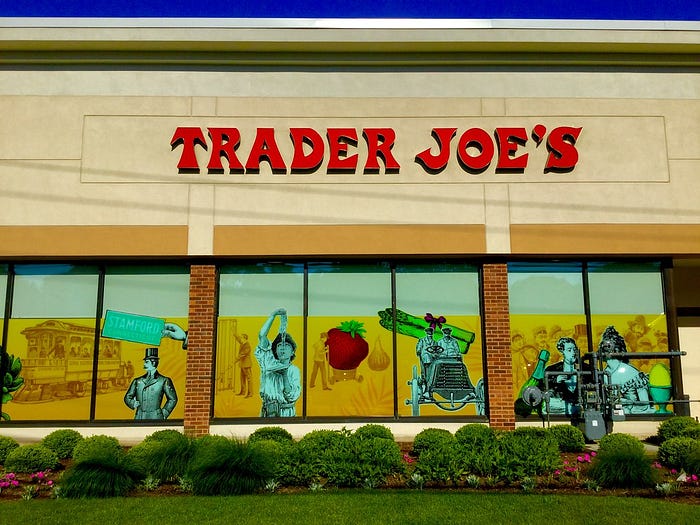Why Brandless failed to become the Procter & Gamble for Millennials
Brandless, a DTC consumer goods company designed to provide groceries and essentials, minus the cost of marketing, ended its operations last week after failing to become profitable. The company was known for its a unique pricing model, where every item cost a uniform price of $3, as well as its clean product packaging. Source: Brandless
Source: Brandless
I have seen a few people claim this as a victory for brands. Brandless’ demise is proof that brands matter!
I disagree. Brands do matter, but that is not the reason that Brandless failed to take off. For one, Brandless is inherently a brand. According to co-founder Tina Sharkey, “Sometimes people might mistake the name Brandless for the idea that we’re anti-brand…We’re unapologetically a brand, but the difference is that in 2017 we’re re-imagining what it means to be a brand.”
Brandless failed because the company failed to connect their marketing and their operations into a cohesive, self-reinforcing business model. To understand why Brandless did not take off, it is necessary to look into Brandless’s business and see how the various elements end up pushing the business model apart.
Breaking down Brandless
Brandless attempted to compete in a tough industry — groceries and consumer goods. There are two broad strategies to win here: you can be the cheapest, and make up for low margins with high volume (a la Wal-mart or Amazon), or you can be expensive but different. Brandless attempted to be everything at once, pointing customers to their low prices, while also attempting to market themselves as high quality, sustainable, and supportive of good causes.
Let’s start with the low-price side of Brandless. Much of Brandless’s offering revolves around them offering a cheaper alternative to brands. As part of their marketing, the company trademarked the term ‘Brand Tax,’ to refer to the additional cost that branded companies like Procter & Gamble spend acquiring customers through branding and advertising, and then pass onto the customer in the form of higher prices. Brandless’s uniform pricing of $3 is supposed to support this idea. There are (2) problems here. One: are the goods actually cheaper? $3 might be cheap for a serrated knife, but it’s not a stunning deal for toothpaste.
Which leads to problem #2: customers who are attracted to this idea of cheap prices are going to look for exactly that: cheap prices. They will cherry-pick the items from Brandless that feel like good value, (e.g. the serrated knife, and others that are low margin for the company) and purchase other items (from brands they know and trust) from Amazon. This keeps Brandless’ margins low, and minimizes opportunities for economies of scale.
The other broad strategy, when not offering the cheapest price, is to offer the best value. Here, again, Brandless missed. Brandless’ products were not necessarily high quality. The internet was full of complaints of broken items, and kitchen goods that started to fall apart after just a few washes. Some products did get good reviews, but for a company looking to drive purchase by the simple addition of a ‘Brandless’ logo, consistent product quality is key.
Finally, despite the term Brand Tax, the company clearly spent money on marketing. They hired trendy New York design firm Red Antler to design their logo and packaging. The firm is otherwise known for designing the branding and advertising for DTC darlings Allbirds sneakers, Casper mattresses and Rent the Runway.
Brandless is no stranger to advertising, either. A quick search on Moat.com reveals a melange of Brandless banner ads: Brandless ads via Moat.com
Brandless ads via Moat.com
When you add it up, you get a formula that reads low margins + ruthless price competition + low quality goods + disloyal customers + +low economies of scale + high marketing expenses.
Trader Joe’s: the brandless brand that could
Now, compare this to Trader Joe’s. From the outside, TJ’s and Brandless might look similar: TJ’s also operates in the competitive grocery industry, and does so by offering products under a single brand (Trader Joe’s) that are miraculously both low priced and high quality.
However, when you look under the hood, you see an operating model that is consistent, focused, and self-reinforcing. Compared to Brandless, TJs is a very different company. Source: Flickr
Source: Flickr
For one, TJ’s actually ensures good quality. It’s nearly impossible to find a bad product in Trader Joe’s. Unlike Brandless, TJ’s does not manufacture their own products. Instead, they pick and choose the best product for each category to stock in their store, allowing them to select high quality products from manufacturers, and move quickly to switch providers for any products not up to snuff. Consumer trust in TJ’s quality then allows the company to stock just one or two variants of each product type (e.g. peanut butter), dramatically lowing TJ’s SKU complexities as compared to other grocery retailers.
Two, TJ’s promises to be cheaper, and they actually are. TJs did not make the mistake of pointing customers toward price, and failing to be the cheapest. Instead, they employ value-based pricing (good quality for the price) and deliver on it.
Much of TJ’s ability to drive prices lower stems from their operational efficiencies. Instead of spending money on marketing, the company spends money on employees, paying on higher than industry average. This investment benefits Trader Joe’s threefold: first, the company reduces turnover, which saves on recruiting expense and training. Second, TJ’s can recruit better talent, which it cross-trains across roles to smooth operations in store. But third, great talent supports TJ’s excellent customer service. The store is known for being a genuinely fun place to shop, and TJ’s boasts a Net Promoter Score of 62, one of the highest in grocery.
Finally, given that the stores themselves are a destination, TJ’s chooses its locations less based off where customers are (which is expensive), and more based off what makes the most sense operationally (to minimize supply chain costs across stores) helping keep costs low.
When you start to sketch out out TJ’s model (which is more complex than I have written below) you see a chain of reinforcing elements:
High quality goods + investments in customer experience and salaries → customer loyalty →word of mouth marketing + low advertising costs + high volumes + low margins+ well-oiled operations →low costs = strong volume game and high loyalty
Picking fights and winning those fights
What emerges on the comparison between Brandless and TJ’s is a difference in focus. Brandless debuted with a grand idea to save customers money by not spending on marketing, but then it did. Their marketing messages then tried to convey both quality and price, while delivering on neither.
TJ’s does not spend on marketing, choosing to invest in other areas such as operations and customer experience, which pay off in the form of lower costs and customer loyalty, which then drive lower prices, higher sales volume and a stronger business model. The story highlights a powerful lesson for managers when considering where to make investments: invest where you can reinforce and strengthen your business model.
A final note
Brandless’ nail in the coffin may well have been its $240M promised funding from Softbank, as the funds came with a caveat of profitability. Whereas Trader Joe’s had the benefit of growing slowly via word of mouth, Brandless was forced to scale on Softbank’s schedule, which could have driven their heavy marketing investments. Perhaps, with smaller funding, the company could have focused on building a self reinforcing business model. Another note for managers: your funding (or lack of) is also a decision that should reinforce your business model.
- I should note that Brandless abandoned their single price model in July 2019. Unfortunately, this was too little too late for the struggling brand.
Don’t miss out on brand insights — Sign up for monthly emails on brand marketing.
Looking for help growing your brand?
I run brand consultancy Embedded — where I partner with founders and C-suite executives to unlock the power of brand.
Not sure where to start? Many clients opt for ad-hoc coaching — hourly consultations on any aspect of your marketing and brand strategy. Get in touch here.
If you liked this story, you may also like:





































